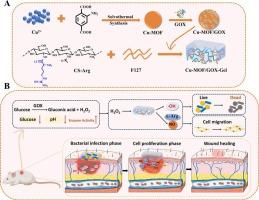Glucose-activated self-cascade antibacterial and pro-angiogenesis nanozyme-functionalized chitosan-arginine thermosensitive hydrogel for chronic diabetic wounds healing
IF 10.7
1区 化学
Q1 CHEMISTRY, APPLIED
引用次数: 0
Abstract
Affected by persistent hyperglycemia, diabetic neuropathy, and vasculopathy hinder the progression of wound healing by exacerbating susceptibility to recurrent bacterial infection and impairing vascularization. In order to cater to the requirements of diabetic chronic wound healing at various stages, we designed an antibacterial and pro-angiogenic wound dressing with localized glucose-lowering capacity. In this study, we constructed a copper-based metal-organic framework (MOF) nanozyme and loaded with glucose oxidase (GOX) to prepare Cu-MOF/GOX, which was subsequently integrated with CS-Arg (chitosan modified by L-Arginine) and Pluronic (F127) to fabricate multifunctional Cu-MOF/GOX-Gel thermosensitive hydrogel. The GOX generated H2O2 (hydrogen peroxide) and gluconic acid by consuming high blood glucose at the wound site, thus initiating an efficient antibacterial self-cascade catalytic in the initial stages of wound healing. With the further catalysis of in situ generated H2O2, NO (nitric oxide) was gradually released from the hydrogel, facilitating angiogenesis and accumulation of collagen, thereby expediting subsequent phases of wound healing. Overall, the Cu-MOF/GOX-Gel exhibits a comprehensive ability to locally regulate blood glucose levels, while also synergistically promoting antibacterial activity and angiogenesis, that effectively chronic diabetic wounds healing.

用于慢性糖尿病伤口愈合的葡萄糖激活型自级联抗菌和促血管生成纳米酶功能化壳聚糖-精氨酸热敏水凝胶
受持续高血糖的影响,糖尿病神经病变和血管病变会加剧反复细菌感染的易感性并损害血管生成,从而阻碍伤口愈合的进展。为了满足糖尿病慢性伤口愈合不同阶段的要求,我们设计了一种具有局部降糖能力的抗菌和促进血管生成的伤口敷料。在这项研究中,我们构建了一种铜基金属有机框架(MOF)纳米酶,并负载葡萄糖氧化酶(GOX)以制备 Cu-MOF/GOX,随后将其与 CS-Arg(由 L-精氨酸修饰的壳聚糖)和 Pluronic(F127)结合,制备出多功能 Cu-MOF/GOX-Gel 热敏水凝胶。GOX 通过消耗伤口处的高血糖产生 H2O2(过氧化氢)和葡萄糖酸,从而在伤口愈合初期启动了高效的抗菌自级联催化。随着原位生成的 H2O2 的进一步催化,NO(一氧化氮)逐渐从水凝胶中释放出来,促进了血管生成和胶原蛋白的积累,从而加快了伤口愈合的后续阶段。总之,Cu-MOF/GOX-凝胶具有局部调节血糖水平的综合能力,同时还能协同促进抗菌活性和血管生成,从而有效地促进慢性糖尿病伤口的愈合。
本文章由计算机程序翻译,如有差异,请以英文原文为准。
求助全文
约1分钟内获得全文
求助全文
来源期刊

Carbohydrate Polymers
化学-高分子科学
CiteScore
22.40
自引率
8.00%
发文量
1286
审稿时长
47 days
期刊介绍:
Carbohydrate Polymers stands as a prominent journal in the glycoscience field, dedicated to exploring and harnessing the potential of polysaccharides with applications spanning bioenergy, bioplastics, biomaterials, biorefining, chemistry, drug delivery, food, health, nanotechnology, packaging, paper, pharmaceuticals, medicine, oil recovery, textiles, tissue engineering, wood, and various aspects of glycoscience.
The journal emphasizes the central role of well-characterized carbohydrate polymers, highlighting their significance as the primary focus rather than a peripheral topic. Each paper must prominently feature at least one named carbohydrate polymer, evident in both citation and title, with a commitment to innovative research that advances scientific knowledge.
 求助内容:
求助内容: 应助结果提醒方式:
应助结果提醒方式:


